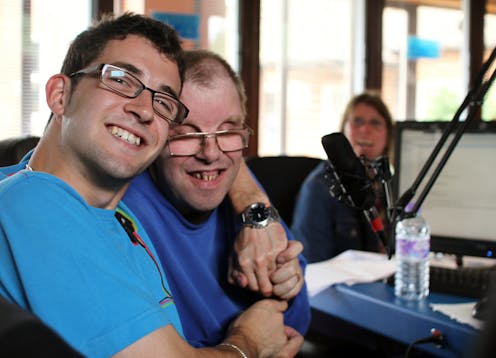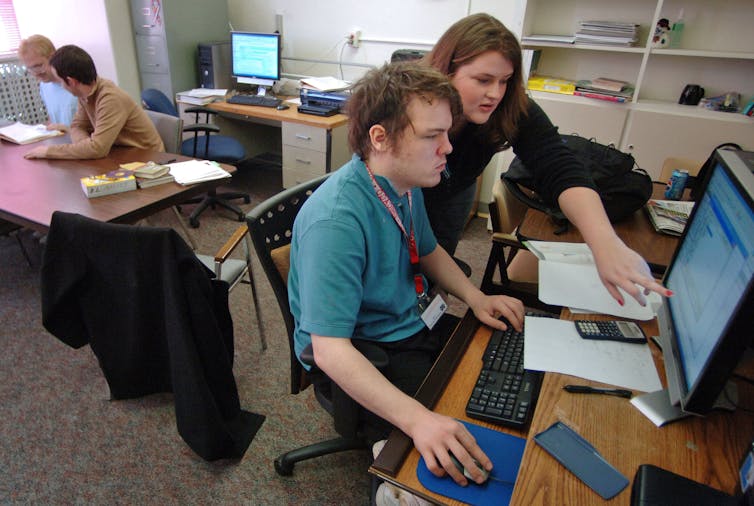
Summer is a busy time for high school juniors. They’re getting ready to say goodbye to school as they know it and they’re researching colleges, visiting campuses and trying to figure out what college fits their needs.
Planning is an important part of this process, but for parents and guardians of students with disabilities, this is especially true.
As a professor and researcher in special education, I’ve worked with many students with disabilities transitioning to college. The ones who are typically most successful after high school are the ones who were prepared to be strong self-advocates, who could seek out needed services and supports, and who could manage the multiple demands of being independent.
These are all skills that can – and should – be taught at the middle and high school level. Whether it’s understanding your child’s disability and legal rights or figuring out what accommodations and study habits work best, preparation is key.

Rob Crandall/Shutterstock.com
A wide range of disabilities on college campuses
According to a 2016 report by the United States Department of Education, approximately 11 percent of all undergraduates report having a disability – up from 6 percent almost two decades prior. Since nearly two-thirds of all students who received special education services in high school did not self-disclose their disability to a college, the actual number of students with disabilities on campuses is likely much higher.
Most of these students have what are often called “nonvisible” disabilities, including learning disabilities, attention deficit/hyperactivity disorder and, increasingly, mental health disorders such as anxiety or depression.
Students with autism spectrum disorders are also more often attending college than a decade ago. And on some campuses, programs are emerging for students with intellectual disabilities.

AP Photo/Jeff Gentner
A change in legal status
Many of these students receive special education services during some (or all) of their kindergarten through 12th grade school years.
For many, these services are provided under the Individuals with Disabilities Education Act of 2004 (IDEA). The IDEA requires a free and appropriate education, in the least restrictive environment, that meets the individual needs of students. A team of professionals work with the student’s family or guardians to develop an Individualized Education Program (IEP). The IEP outlines the student’s strengths and needs, sets annual goals and determines what modifications might be required to help the student meet those goals.
Other students with disabilities don’t need IDEA. They qualify for services under Subpart D of Section 504 of the Rehabilitation Act of 1973, which is a civil rights law (not a special education law) that prohibits discrimination on the basis of disability.
However, in both of these cases, services end at graduation. Special education services and individualized support and instruction required by the IDEA are not available in college.
At the college level, students with disabilities may be covered under a different part of the Rehabilitation Act. (Subpart D of Section 504 covers K-12, while Subpart E covers post-secondary.) Subpart E protects college students with disabilities against discrimination and requires that they be provided equal access to all aspects of the academic program and facilities – provided that the student gains admission into college and maintains eligibility to remain enrolled, without consideration of their disability.

White House photo by Tina Hager
If admitted, and if the student would like to receive accommodations, they must seek out disability services and provide the college with required information about the nature of the disability and how it impacts access to the physical environment or to learning. Often called “documentation,” the specific requirements vary based upon disability type and, often, the college that the student attends.
It’s important to note that it’s the student’s choice to seek out and to use services at the college level. But it’s also important to know that students must self-identify as having a disability or else they’re not eligible for services – the college does not need to seek students out.
How families can prepare
There are several things that families can do to get ready for life after high school. The list below is by no means exhaustive. Each student with a disability has unique needs and questions that should be addressed.
In general, however, students and their families should:
• Learn more about the disability and the student’s unique characteristics. When leaving high school, the student should understand his or her own strengths, preferences and weaknesses – to be able to self-advocate, to use and adjust learning strategies that work for him or her, and to independently make life choices.
• Become active in the IEP or Section 504 process and be active members of the team that develops and monitors the individualized plan. Students are often left out of this process, but should be included as early as is appropriate and to the greatest extent possible, based on the student’s skills.
• Learn about accommodation needs. Students and families can work with individual teachers to request and set these up. High school is a great time for a student to learn how to monitor what’s useful and what’s not. Learning which accommodations are really needed will be an important skill in college or work life.
• Transition away from any modifications to instruction, tests or grading, and focus on the use of learning strategies. Changes to teaching methods and tests are generally not provided after high school.
• Work on time management skills. The college day is much less structured than the high school day. This creates many exciting opportunities for students, but also challenges. Students need to be prepared to productively and independently handle this free time.
• Research the disability supports offered at different colleges. Section 504 only requires colleges to ensure access and prohibit discrimination, but many colleges provide more extensive services and supports. This may affect what colleges you want to visit or apply to.

Creatista/Shutterstock.com
An exciting option
Once you know what life after high school will bring, there’s even more you can do to prepare: Learn about the documentation requirements for the college you’ve chosen, get in touch with disability services and talk about needed accommodations and supports, and if appropriate for a student, think about transportation needs and access to medication or doctors.
But the most important thing is to simply start looking forward to the challenge ahead of you. College presents an exciting and viable option for students with disabilities. With preparation in high school (and knowing what to do when you actually arrive on campus) students with disabilities can succeed in college – or in whatever life after high school they choose.
![]()
Joseph Madaus receives funding from the Connecticut State Department of Education; the United States Department of Education.
